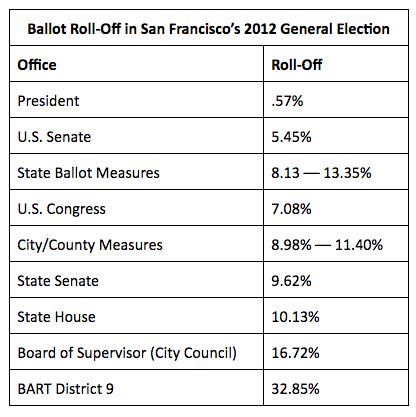There Are Millions of Documented Cases of Missing Votes... And It’s Likely Happened to You

Editor's note: This article was written by Nick Troiano, Dane Sherrets, and Chis Walsh. It was published with permission from all authors.
Election Day is two weeks away. Let’s assume you’re a good citizen and will vote. What will you do when you inevitably get to a race on your ballot in which you don’t know anything about the candidates? Heck, you might not even know what a Comptroller, University Regent, or District Magistrate does.
You may go with “eeny, meeny, miny, moe,” or follow a candidate’s party affiliation, or even choose a gender. Or you may just leave it blank and move on. You’re not alone. We’ve all been there, no matter how politically engaged we are.
Overall, it’s hard to know how frequently these shortcuts occur in voting, but we can tell from comparing participation in particular races to total voter turnout that the act of skipping races happens more often than you might think.
During the last presidential election in San Francisco, for example, a whopping one-third of voters skipped choosing a candidate for their representative on the transportation board (BART). Nearly one in ten voters did the same for State House and State Senate. These numbers are roughly typical across the country. In a new white paper (“Stop, Drop and Roll-Off: The Challenge of Voting in Local Elections”), we explore the causes and consequences of these missing votes -- otherwise technically known as ballot roll-off.
Consider the case of Natalie Menten. She was elected to Colorado’s Regional Transportation District in 2012 and now represents 180,000 people on a 15-member board that manages transportations services for 2.9 million people and oversees a $467 million budget.
Menten spent just $10 on her first election, won over 31,000 votes, and upon assuming her position, immediately began opposing various RTD initiatives as an outspoken fiscal hawk. Regardless of whether one agrees with her positions, the most troubling part about her election was that more people skipped voting in her race than actually voted for Menten, and she won by only 115 votes out of more than 62,000 cast.
“Important public policy decisions are being made without the input of most of the affected residents,” write researchers Zoltan Hajnal and Paul Lewis. "It’s at the local level, they argue, “where policies are most likely to be implemented and where a majority of the nation’s civic leaders are being elected.”
Indeed, 96% of elected officials are elected at the local level, and nearly a third of all tax revenue is collected by local and state governments. Further, bills introduced in state legislatures are more than four times likely to be enacted into law than legislation in Congress. It might seem counter-intuitive, but with Washington gridlocked, the relative impact of local government is only growing.
There are a variety of reasons for ballot roll-off, but most research suggests that a lack of information about the candidates is the primary cause of the problem. After all, state and local candidates are less likely to be covered by media and less likely to have the resources necessary to run robust campaigns.
In our view, now is the time for technology to bridge this gap and lower the barrier to local voting. In an age when all the world’s information is at our fingertips, citizens should be able to see who is going to be on their ballot as easily as they can check the weather. Imagine having a digital version of your physical ballot available alongside an aggregation of relevant news reports, candidate communications, campaign finance data, crowdsourced recommendations, and much more.
Several non-profits and companies, such as Brigade, Google, and Ballotpedia, are already working to make this “killer app” for democracy. Yet they are collectively hamstrung by inaccessible elections data held by thousands of local counties and municipalities. It is hard to produce an accurate sample ballot, for example, when necessary information is buried in a PDF somewhere on a local government website or, worse, on actual paper locked in a drawer of a bureaucrat’s desk. State secretaries of state should turn up the pressure and provide resources to modernize these systems.
While it may take another election cycle or two before you can open a smartphone app to easily help you fill out your entire ballot, rest assured that most of this information is already out there. So let’s take the time and prepare to vote for all offices and measures, because the contests and candidates we may hear about the least may be the ones that affect us the most.
Read Nick Troiano, Dane Sherrets, and Chis Walsh's full white paper:
Nick Troiano, Dane Sherrets, and Chris Walsh previously worked for Change.org to develop a new platform (not yet launched) that helps voters make informed decisions in elections. Their white paper was made possible through the support of this project.
Photo Credit: Alexandru Nika / shutterstock.com




